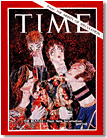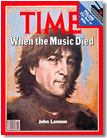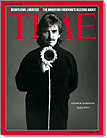Quotes of the Day

![]() It was, my editors had assured me, a dream assignment. And I, as a 26-year-old trainee in TIME's Washington bureau, was lucky to get it. Maybe so. But then why was I shivering alone on a corner of Manhattan's Fifth Avenue on this cold February night? The subjects I was supposed to be covering were ensconced 12 floors above me in the Plaza Hotel, encircled by a cadre of security gargoyles dedicated to making sure that neither I nor anybody else got anywhere near them. I'd been tracking them all day, but even the few quotes and details I'd gleaned had also been picked up by hundreds of competing journalists. So where was the dream part?
It was, my editors had assured me, a dream assignment. And I, as a 26-year-old trainee in TIME's Washington bureau, was lucky to get it. Maybe so. But then why was I shivering alone on a corner of Manhattan's Fifth Avenue on this cold February night? The subjects I was supposed to be covering were ensconced 12 floors above me in the Plaza Hotel, encircled by a cadre of security gargoyles dedicated to making sure that neither I nor anybody else got anywhere near them. I'd been tracking them all day, but even the few quotes and details I'd gleaned had also been picked up by hundreds of competing journalists. So where was the dream part?
|
|
||
|
|
 Sept. 22, 1967 View Larger Purchase Cover  May 31, 1976 View Larger Purchase Cover  Dec. 22, 1980 View Larger Purchase Cover  Dec. 10, 2001 View Larger Purchase Cover |
|
|
|
||
|
|
|
|
|
|
||
The crucible moment of the tour was their performance on the Ed Sullivan TV show on Sunday night, Feb. 9. Some 73 million Americans tuned in that night, the largest viewership in the history of television to that point. More than 50,000 fans and curiosity-seekers had applied for seats in the studio audience, of whom only 728 could be accommodated. I was one of the reporters watching from the back of the theater. (Maybe this actually was a dream assignment.) What struck us journalists that night was the noise that engulfed the Beatles as they trotted out onstage — intense, high-pitched, piercing. We agreed that it was louder, more frenzied, than Frank Sinatra's fans had ever been, or even Elvis Presley's. And it never let up: you could hardly hear the five songs the Beatles sang. Three nights later, when the Beatles played two concerts in Carnegie Hall, New York Times critic John S. Wilson reviewed the pandemonium of the audience as if it were the performance and the Beatles a barely audible accompaniment.
Did any of us — journalists, fans, the public, the Beatles — sense that all this hullabaloo represented the upswelling of the heady, tumultuous '60s, an early wave in what would become a tsunami of rock 'n' roll and social and political upheaval? I don't believe so. The decade had begun, it's true, with civil rights demonstrations and protests against the Bomb. And the Beatles' arrival came just months after the shattering event of President Kennedy's assassination. But Woodstock, the Vietnam Quagmire, the hippie phenomenon, the killings of Martin Luther King and Robert Kennedy‘all this and more was still ahead, and largely unforeseen.
Just as the '60s weren't quite the '60s yet, so the Beatles weren't quite the Beatles. They were delightful celebrities. It would take a couple more years and the release of albums like "Rubber Soul," "Revolver" and especially "Sgt. Pepper's Lonely Hearts Club Band" for us to see that they were also brilliant musical innovators.
So onward rolled the merry caravan, through more press conferences and high jinks, by train to Washington, D.C., where the lads played a concert at the Coliseum and partied at the British Embassy, back to New York City, then by plane to Miami, where a second appearance was scheduled on the Ed Sullivan Show, this time live from the Deauville Hotel in Miami Beach.
 Now and again I managed to snatch a moment of face-to-face conversation with one of the foursome. On the Miami flight I crept into the first class cabin to interview Lennon, and returned bearing the stunning intelligence that his then wife Cynthia, who was traveling with the group, cut his hair with fingernail scissors. In a documentary film of the tour made by Albert and David Maysles, I can be seen joshing with Ringo Starr at a cocktail reception over whether Beatlemania was "all just a con." This bit of footage, authenticating that I had once basked in the presence of a Beatle, would in later years endow me with a measure of heroism in the eyes of my three children.
Now and again I managed to snatch a moment of face-to-face conversation with one of the foursome. On the Miami flight I crept into the first class cabin to interview Lennon, and returned bearing the stunning intelligence that his then wife Cynthia, who was traveling with the group, cut his hair with fingernail scissors. In a documentary film of the tour made by Albert and David Maysles, I can be seen joshing with Ringo Starr at a cocktail reception over whether Beatlemania was "all just a con." This bit of footage, authenticating that I had once basked in the presence of a Beatle, would in later years endow me with a measure of heroism in the eyes of my three children.
Now, however, I had to get back to New York for the unheroic task of closing TIME's story. The system in those days was that correspondents like me would send in voluminous "files" from which a staff writer would distill the polished piece that ran in the magazine. In this case the writer was John McPhee, who would go on to become a distinguished contributor to The New Yorker and author of 25 books, including "Coming into the Country" and "Annals of the Former World." John's story, to my chagrin, used only a few snippets of my material. But it was a breezy, bemused account that had something my reporting lacked: perspective. I hope I learned something from it. In any case, two and a half years later, I got my own back. When the release of "Sgt. Pepper" prompted TIME to put the Beatles on the cover — becoming one of the first major U.S. publications to do so — the writer of the story was me.![]()
- Christopher Porterfield
- A longtime editor of TIME who covered the Fab Four reflects back upon the group's first frenzied visit to the States 40 years ago